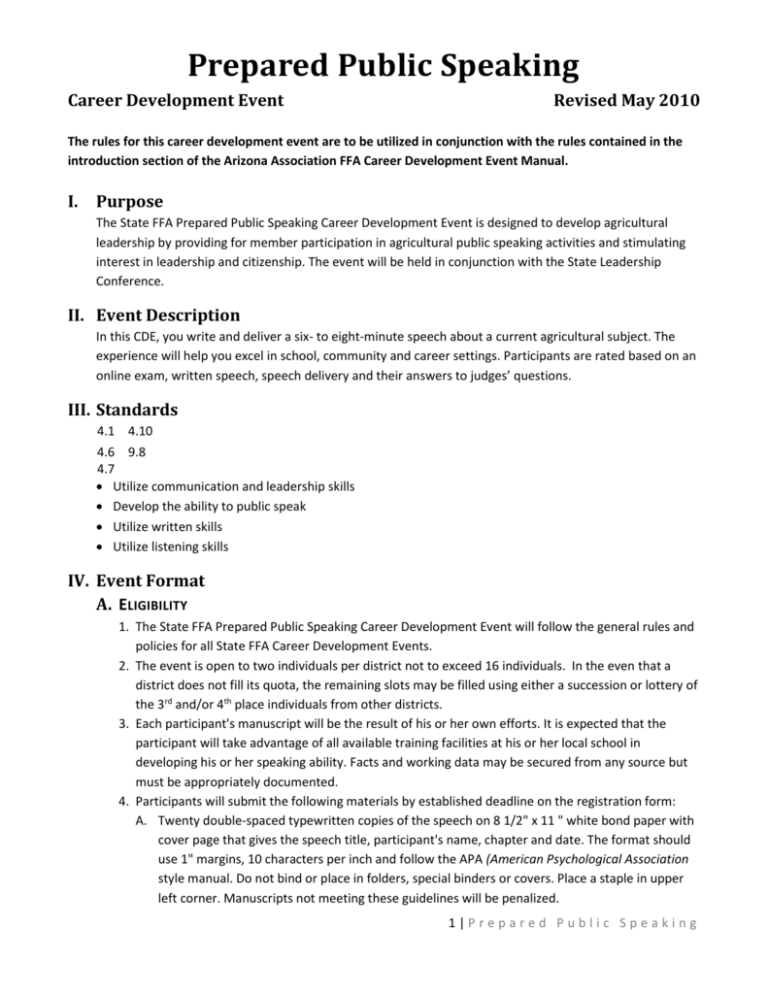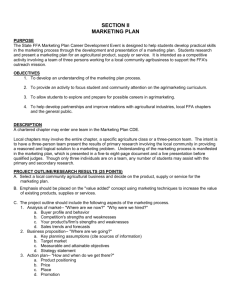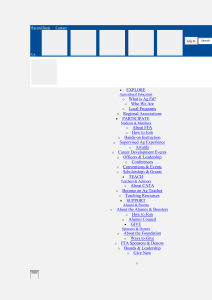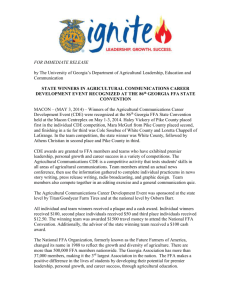Prepared Public Speaking
advertisement

Prepared Public Speaking Career Development Event Revised May 2010 The rules for this career development event are to be utilized in conjunction with the rules contained in the introduction section of the Arizona Association FFA Career Development Event Manual. I. Purpose The State FFA Prepared Public Speaking Career Development Event is designed to develop agricultural leadership by providing for member participation in agricultural public speaking activities and stimulating interest in leadership and citizenship. The event will be held in conjunction with the State Leadership Conference. II. Event Description In this CDE, you write and deliver a six- to eight-minute speech about a current agricultural subject. The experience will help you excel in school, community and career settings. Participants are rated based on an online exam, written speech, speech delivery and their answers to judges’ questions. III. Standards 4.1 4.10 4.6 9.8 4.7 Utilize communication and leadership skills Develop the ability to public speak Utilize written skills Utilize listening skills IV. Event Format A. ELIGIBILITY 1. The State FFA Prepared Public Speaking Career Development Event will follow the general rules and policies for all State FFA Career Development Events. 2. The event is open to two individuals per district not to exceed 16 individuals. In the even that a district does not fill its quota, the remaining slots may be filled using either a succession or lottery of the 3rd and/or 4th place individuals from other districts. 3. Each participant's manuscript will be the result of his or her own efforts. It is expected that the participant will take advantage of all available training facilities at his or her local school in developing his or her speaking ability. Facts and working data may be secured from any source but must be appropriately documented. 4. Participants will submit the following materials by established deadline on the registration form: A. Twenty double-spaced typewritten copies of the speech on 8 1/2" x 11 " white bond paper with cover page that gives the speech title, participant's name, chapter and date. The format should use 1" margins, 10 characters per inch and follow the APA (American Psychological Association style manual. Do not bind or place in folders, special binders or covers. Place a staple in upper left corner. Manuscripts not meeting these guidelines will be penalized. 1|Prepared Public Speaking Prepared Public Speaking Career Development Event Revised May 2010 B. A signed statement of originality on the certification form provided. C. A complete and accurate bibliography used in writing the speech. All participants in State FFA Prepared Public Speaking Career Development Event should give credit to others where any direct quotes, phrases or special dates are used in the manuscript, in order not to be guilty of plagiarism. A bibliography MUST be included as part of the public speaker's manuscript and direct quotes from any source of information must be marked in "quotes" on the manuscript and be identified in the bibliography. Failure to do so will automatically disqualify a participant. This applies to all events above the local level. Factual information pertaining to agriculture is available from the United States Department of Agriculture, Washington, DC 20250; state colleges, research centers and/or experiment stations; or the Superintendent of Documents, U. S. Government Printing Office, Washington, DC 20402. 5. A participant shall wear complete official FFA dress as defined in the current Official FFA Manual. B. SUBJECTS Participants may choose any current subject for their speeches that is of an agricultural character (nature), which may include: agriscience technology agribusiness agrimarketing international agricultural relations agricultural communications Official judges of any State FFA Prepared Public Speaking Career Development Event shall disqualify a participant if he or she speaks on a nonagricultural subject. C. TIME LIMIT Each speech shall be a minimum of six minutes in length and a maximum of eight minutes. Each participant will be allowed five minutes additional time in which he or she will be asked questions relating to his or her speech. Participants will be penalized one point per second on each judge's score sheet for being under six minutes or over eight minutes. No time warnings will be given by event officials or observers. D. EVENT PROCEDURES 1. The State FFA Executive Secretary will assign a chair to this event. 2. A 50-question, multiple choice, online exam will be taken prior to the event. The State FFA Office will distribute further information regarding the administration of the exam. 3. Prior to the event the content and composition of all manuscripts will be scored by one qualified individual who will record the scores on a score sheet that will be provided. The scored manuscripts will be provided to the chairman after each participant has presented. A list of 10 questions for each manuscript will also be developed and provided to the CDE Chairperson to use at his/her discretion throughout the process. 2|Prepared Public Speaking Prepared Public Speaking Career Development Event Revised May 2010 4. The speaking order will be randomly determined by event officials. The program chairman shall introduce each participant by name and in order of the drawing. A participant will be permitted to use note cards while speaking, but up to a deduction of 10 points may be given. No props are to be used. Applause shall be withheld until all participants have spoken. A tiered system will be used at the professional discretion of the CDE Chairperson for assessing deductions as follows: a. No cards used = 0 deductions b. Note cards used some = 5 point deduction c. Note cards used excessively = 10 point deduction 5. One timekeeper shall be designated who will record the time used by each participant in delivering his or her speech, noting under time or overtime, if any, for which deductions will be made. 6. An accuracy judge will be designated to keep track of any missed/added words throughout the event. Professional discretion shall be used in assessing deductions as follows: a. Few words missed/added (i.e. 10 words or less) = 0 deductions b. Moderate words missed/added (i.e. 1-2 sentences) = 5 point deduction c. Excessive words missed/added (i.e. paragraph or more) = 10 point deduction 7. The state event will be conducted in two rounds: semifinals and finals. No ranking will be given except for the final four. Preliminary rounds will be conducted at the district level. 8. A judge shall be provided by each school, for each contestant registered in the Prepared Public Speaking CDE. This judge will be utilized in the same semi-final round as his/her student. During that round, the judge will not score his/her own student. Failure to provide a judge may result in the disqualification of the student from the event. If a student/judge arrives late to the judges meeting (or leaves before the end of the meeting) professionalism points will be deducted from the students score in both the preliminary (and finals if appropriate) round(s). 9. The CDE Chairperson will meet with all judges, coaches and contestants prior to the semi-final round and will discuss the procedure for the event, the scorecards, the scoring procedure, the meeting following the conclusion of the speeches and answer any questions. The CDE Chairperson will also inform coaches and contestants when and where they will be notified of the results from the semifinal round. 10. Each judge shall formulate and ask questions. Questions shall pertain directly to the speaker's subject. Judges will score each participant on the ability to answer all questions asked by all judges. Three to five minutes for questions should be used. 11. When all participants have finished speaking, each judge will total the score on delivery and response to questions for each participant. The composition score, the accuracy score and the timekeepers' record will then be given to all judges and used in computing the final score for each participant. Judges will rank the contestants (based on the total scores) from 1 to 8 (with 1 being the highest). The judges' score sheets will then be submitted to event officials to determine final ranking of participants. 12. The judges' ranking of each participant then shall be added, and the top two contestants from each round will be the participants whose total of rankings are the lowest. This calculation is to be done without consultation between judges. Other placings shall be determined in the same manner (low 3|Prepared Public Speaking Prepared Public Speaking Career Development Event 13. 14. 15. 16. 17. 18. 19. Revised May 2010 point score method of selection). In case of a tie, that individual who has the highest grand total score shall have higher rating. The top two participants from each semi-final round will be eligible to advance to the final round. The CDE Chairperson will meet with all judges, coaches and contestants prior to the final round and will discuss the procedure for the event, the scorecards, the scoring procedure, the meeting following the conclusion of the speeches and answer any questions. For the final round, a minimum of three competent and impartial persons will be selected to judge. At least one judge should have an agricultural background. The judges will be seated in different sections of the room in which the event is held. They will score each participant on the delivery of production, using the score sheet provided. Each judge shall formulate and ask questions. Questions shall pertain directly to the speaker's subject. Judges will score each participant on the ability to answer all questions asked by all judges. Three to five minutes for questions should be used. When all participants have finished speaking, each judge will total the score on delivery and response to questions for each participant. The composition score, the accuracy score and the timekeepers' record will then be given to all judges and used in computing the final score for each participant. Judges will rank the contestants (based on the total scores) from 1 to 4 (with 1 being the highest). The judges' score sheets will then be submitted to event officials to determine final ranking of participants. The judges' ranking of each participant then shall be added, and the winner will be that participant whose total of rankings is the lowest. This calculation is to be done without consultation between judges. Other placings shall be determined in the same manner (low point score method of selection). In case of a tie, that individual who has the highest grand total score shall have higher rating. The CDE Chairperson is to deliver the results to the State FFA Executive Secretary immediately following the conclusion of the judges’ final meeting. V. Tiebreakers In the event of a tie, the judges’ raw score will be used to determine rankings. If a tie still exists, the online exam score will be utilized. VI. Awards Plaques will be awarded to the state finalists by the Arizona Association FFA. A cash award of $225 will be awarded to the state winner. 4|Prepared Public Speaking Prepared Public Speaking Career Development Event Revised May 2010 VII. References SAMPLE COVER PAGE SAMPLE FIRST PAGE FORMAT The Biotechnology of Agriculture FFA makes a positive difference in the lives of students by developing their potential for premier leadership, personal The Biotechnology of Agriculture growth and career success through agricultural education. FFA makes FFA makes a positive difference in the lives of students by developing their potential for premier leadership, personal growth and career success through agricultural education. FFA By makes FFA makes a positive difference in the lives of students James A. Smith by developing their potential for premier leadership, personal Chandler FFA Chapter growth and career success through agricultural education. FFA State FFA Prepared Public Speaking Career Development Event 2008 makes. 1 SAMPLE BIBLIOGRAPHY ENTRIES Bibliography Borlaug, Norman. “Feeding the World.” Farm Industry News, November 1992, pp 21-22. National Research Council (NRC). (1988). Understanding Agriculture: New Directions for Education. Washington D.C.: National Academy Press. Romans, J.R., Costello, W.J., Carlson (1994) The Meat We Eat. (13th ed.) Danville, IL. Arizona FFA Online CDE Test Bank (to be distributed by CD annually) 5|Prepared Public Speaking Prepared Public Speaking Career Development Event VIII. Scoring Revised May 2010 STATE FFA PREPARED PUBLIC SPEAKING CAREER DEVELOPMENT EVENT JUDGES' SCORE SHEET Items to be Scored Max. 1 2 3 4 5 Content of Manuscript 10 Importance/appropriateness of the subject, suitability of the material used, Accuracy of the statements included, Evidence of purpose, Completeness and accuracy of bibliography and Relationship to agriculture Composition of Manuscript 10 Organization of content, unity of thought, logical development, language, sentence structure, accomplishment of purpose, conclusions, spelling & grammar Voice 10 Quality, Pitch, Articulation, Pronunciation and Force Stage Presence 10 Personal appearance, Poise and body posture, Attitude, Confidence, Personality and Ease before audience Power of Expression 10 Fluency, Emphasis, Directness, Sincerity, Communicative ability and Conveyance of thought and meaning Response to Question 30 The ability to answer satisfactorily the questions on the speech that are asked by the judges indicating originality, familiarity with subject and ability to think quickly. General Effect 20 Includes the extent to which the speech was interesting, understandable, convincing, pleasing and held attention. TOTAL POINTS (Gross) 100 max Less Time Deductions** Less Accuracy Deduction* Less Notecard Deduction Less Professionalism Point Deduction*** (applied to both prelim and finals rounds) SUBTOTAL POINTS 7 1 pt/ sec Up to 10 pts Up to 10 pts 10 100 max Multiply subtotal by .75 75 Test & Workplace Employability Score multiplied by .25 25 Grand total 6 100 Pts max Rank of Participant *From accuracy judge’s record **From the timekeeper's record ***Based on student/judges being on time and present for entire judges meeting ****Based on student being registered for event by deadline 6|Prepared Public Speaking 8 Prepared Public Speaking Career Development Event Revised May 2010 Speaking Finalist Judge Comment Card This card will be filled out by each finalist judge for each speaker in the finals round. The Speaking CDE Chair will collect the forms and distribute to the finalist (if time permits) or deliver to the State FFA Executive Secretary to be distributed after the event. Name: Chapter: Positives: Areas of Improvement: General Comments: 7|Prepared Public Speaking Prepared Public Speaking Career Development Event Revised May 2010 Prepared Public Speaking Manuscript Rubric Content Max Low Medium High 1. Importance and appropriateness of the subject and relationship to agriculture 3 the topic on the periphery and affects only a small population of the agricultural industry topic is relavent and current; the approach taken limits the scope and focuses in detail on only one side of the issue. topic clearly is related to current issues facing the agricultural industry; the approach taken allows for a wide variety of audience members to identify with the issue 2. Suitability of materials used 1 limited examination of evidence is present; manuscript vaguely addresses evidence about topic; interpretations are exaggerated and/or unfounded adequate examination of evidence is present; evidence is adequately linked to specific data about topic; fact based conclusions are included; interpretations occasionally go beyond normal limits of evidence clear examination of evidence is present; conclusions drawn from evidence are fact-based and warranted; strong connection between evidence and conclusions are demonstrated; interpretation of evidence is within normal limits 3. Accuracy of statements included 2 lack of care in some and or all statements used; there is reason to believe that the statements were skewed so that desired conclusions could be proved Work exhibits some lack of care in taking in statements used; there is no evidence that the statements were skewed; appropriately excludes invalid statements Work exhibits great care was taken in all statements used; there is no evidence that the student skewed the statements; reports and appropriately excludes invalid data 4. Evidence of purpose 2 the purpose statement is incomplete, vague or imprecise the purpose statement is correct and concise, but is little more than a summary statement the purpose statement provides clear and detailed information about the goal of the manuscript 5. Completeness and accuracy of bibliography 2 few, if any, of the sources are related to the topic; mostly one source type (i.e., internet sites, books, etc.) and none are written at the appropriate level for the projects purpose; APA style either not used or used poorly sources cover the topic, but are less interesting and the relationship to the project is less clear; the sources selected are less varied, but most are written at the appropriate level for the project ’s purpose; use of APA style evident but not accurate sources are interesting and they are all clearly related to the topic; a variety sources selected and they are all written at the appropriate level for the projects purpose; correctly uses APA style Total Content Score 10 8|Prepared Public Speaking Prepared Public Speaking Career Development Event Revised May 2010 Composition Max Low Medium High 1. Organization of content 1.5 the text lacks an organizational plan; the text lacks an introduction or conclusion 2. Unity of thought 1 the text does not coherently connect most or any of its ideas, exhibiting a fundamental lack of integration in word, phrase, sentence and paragraph the organizational plan of the text is not uniformly executed, and suffers from conceptual gaps; introduction or conclusion are underdeveloped the text expresses some ideas coherently, but with apparent difficulties at one or more of the following levels: word, phrase, sentence or paragraph begins with an informative introduction and ends with a summative conclusion; the text follows a discernible organizational plan uniformly and with no conceptual gaps the text expresses ideas coherently interwoven at all levels, explicitly integrating words, phrases, sentences and paragraphs into this pattern 3. Logical development 1 the text lacks basic support for its case, using little or no effective argumentation or evidence or logical development the text demonstrates partial support for the case but needs considerable improvements in logical development 1.5 uses simplistic, bland language uses language which is appropriate for the task (e.g., descriptive language when describing, clear and concise language when giving information and explaining, persuasive language when persuading) clarity is compromised, as the text contains obvious linguistic or manuscript preparation errors summary statement(s) is/are present; final conclusions are adequately addressed; conclusions address evidence about topic; conclusions are adequate for evidence; conclusions provide some linkage with focus the text establishes compelling support for the thesis on the basis of logical development of the argument and accurate, pertinent, authoritative, and appropriately documented evidence uses language in highly effective ways to emphasize or enhance the meaning of the message; as appropriate to the task a variety of language techniques such as vivid language, emotional language, humor, imagery, metaphor, simile are used the text exhibits exceptional clarity through the mastery of linguistic and principles 4. Language used 5. Sentence Structure 1 the text lacks clarity as it neglects basic linguistic principles 6. Accomplishment of purpose conclusions 2 no final summary statement(s)/ conclusions present; no use of evidence in final conclusions; final conclusions not linked to initial focus; summation does not describe previous evidence 7. Spelling and grammar 2 manuscript has numerous composition errors; manuscript has not been carefully or systematically edited; paper demonstrates a poor grasp of spelling, grammar, and/or punctuation; errors significantly detract from the paper Total Composition Score 10 Grand Total Manuscript Score 20 manuscript has some composition errors and/or has not been thoroughly edited; paper demonstrates some, but not complete evidence of understanding of composition /editing; errors detract from the content of the paper strong summary statement with final, overall conclusions is present; conclusions contain synthesis of various points of evidence; conclusions are warranted from evidence previously presented;\ conclusions and summary reiterate initial focus, direction, and rationale manuscript demonstrates mature composition and editing with few/no spelling, grammar or punctuation errors; mature composition adds to the overall effect of the content of the paper 9|Prepared Public Speaking Prepared Public Speaking Career Development Event Revised May 2010 Protocols for Speaking CDE Chairperson Judge Preparation Thank the judges for their time and their professionalism. Explain the scorecard to the judges to be sure that they understand what they are looking for. Review the format of the CDE including important topics such as drawing for order. For prepared and creed, choose which judge asks which question and in what order. Judges are only responsible for certain areas (i.e. accuracy, time, presence). Explain what to look for in question answers o Answering questions completely o Answering all parts of multiple part questions o Accuracy & knowledge o Organization of answer o Confidence Confidentiality of scores Written feedback should be taken given only to finalists after CDE Scoring Each judge totals their scores and ranks contestants o 1 being best, 2 being second best, etc. Chair collects rankings and totals. Rankings should be handed to chair (in lieu of verbally reporting results). The lowest sum of rankings is the winner, next lowest is 2nd, etc. Chair then discloses the final results to the judges. If the judges have concerns, the chair will re-tally. No discussion will take place. Finals judges will submit written feedback for the contestants to review. All placings should be confidential. 10 | P r e p a r e d P u b l i c S p e a k i n g







